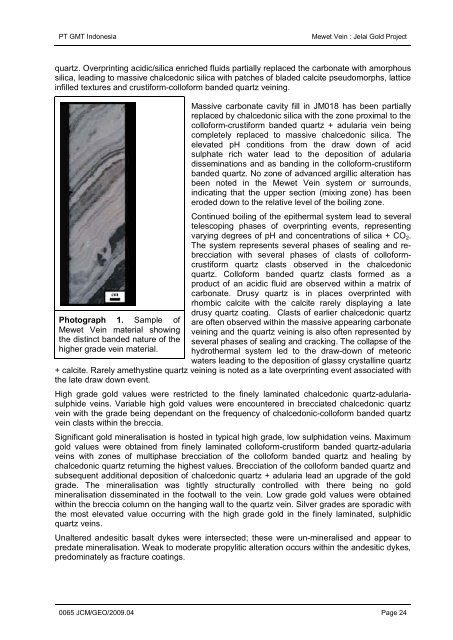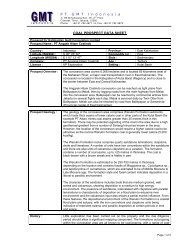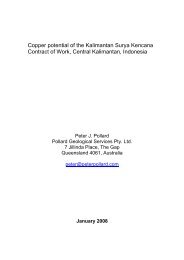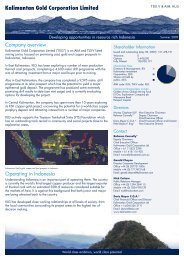Geology and mineralisation of the Mewet Vein, Jelai Gold Project ...
Geology and mineralisation of the Mewet Vein, Jelai Gold Project ...
Geology and mineralisation of the Mewet Vein, Jelai Gold Project ...
You also want an ePaper? Increase the reach of your titles
YUMPU automatically turns print PDFs into web optimized ePapers that Google loves.
PT GMT Indonesia<br />
<strong>Mewet</strong> <strong>Vein</strong> : <strong>Jelai</strong> <strong>Gold</strong> <strong>Project</strong><br />
quartz. Overprinting acidic/silica enriched fluids partially replaced <strong>the</strong> carbonate with amorphous<br />
silica, leading to massive chalcedonic silica with patches <strong>of</strong> bladed calcite pseudomorphs, lattice<br />
infilled textures <strong>and</strong> crustiform-coll<strong>of</strong>orm b<strong>and</strong>ed quartz veining.<br />
Photograph 1. Sample <strong>of</strong><br />
<strong>Mewet</strong> <strong>Vein</strong> material showing<br />
<strong>the</strong> distinct b<strong>and</strong>ed nature <strong>of</strong> <strong>the</strong><br />
higher grade vein material.<br />
Massive carbonate cavity fill in JM018 has been partially<br />
replaced by chalcedonic silica with <strong>the</strong> zone proximal to <strong>the</strong><br />
coll<strong>of</strong>orm-crustiform b<strong>and</strong>ed quartz + adularia vein being<br />
completely replaced to massive chalcedonic silica. The<br />
elevated pH conditions from <strong>the</strong> draw down <strong>of</strong> acid<br />
sulphate rich water lead to <strong>the</strong> deposition <strong>of</strong> adularia<br />
disseminations <strong>and</strong> as b<strong>and</strong>ing in <strong>the</strong> coll<strong>of</strong>orm-crustiform<br />
b<strong>and</strong>ed quartz. No zone <strong>of</strong> advanced argillic alteration has<br />
been noted in <strong>the</strong> <strong>Mewet</strong> <strong>Vein</strong> system or surrounds,<br />
indicating that <strong>the</strong> upper section (mixing zone) has been<br />
eroded down to <strong>the</strong> relative level <strong>of</strong> <strong>the</strong> boiling zone.<br />
Continued boiling <strong>of</strong> <strong>the</strong> epi<strong>the</strong>rmal system lead to several<br />
telescoping phases <strong>of</strong> overprinting events, representing<br />
varying degrees <strong>of</strong> pH <strong>and</strong> concentrations <strong>of</strong> silica + CO 2 .<br />
The system represents several phases <strong>of</strong> sealing <strong>and</strong> rebrecciation<br />
with several phases <strong>of</strong> clasts <strong>of</strong> coll<strong>of</strong>ormcrustiform<br />
quartz clasts observed in <strong>the</strong> chalcedonic<br />
quartz. Coll<strong>of</strong>orm b<strong>and</strong>ed quartz clasts formed as a<br />
product <strong>of</strong> an acidic fluid are observed within a matrix <strong>of</strong><br />
carbonate. Drusy quartz is in places overprinted with<br />
rhombic calcite with <strong>the</strong> calcite rarely displaying a late<br />
drusy quartz coating. Clasts <strong>of</strong> earlier chalcedonic quartz<br />
are <strong>of</strong>ten observed within <strong>the</strong> massive appearing carbonate<br />
veining <strong>and</strong> <strong>the</strong> quartz veining is also <strong>of</strong>ten represented by<br />
several phases <strong>of</strong> sealing <strong>and</strong> cracking. The collapse <strong>of</strong> <strong>the</strong><br />
hydro<strong>the</strong>rmal system led to <strong>the</strong> draw-down <strong>of</strong> meteoric<br />
waters leading to <strong>the</strong> deposition <strong>of</strong> glassy crystalline quartz<br />
+ calcite. Rarely amethystine quartz veining is noted as a late overprinting event associated with<br />
<strong>the</strong> late draw down event.<br />
High grade gold values were restricted to <strong>the</strong> finely laminated chalcedonic quartz-adulariasulphide<br />
veins. Variable high gold values were encountered in brecciated chalcedonic quartz<br />
vein with <strong>the</strong> grade being dependant on <strong>the</strong> frequency <strong>of</strong> chalcedonic-coll<strong>of</strong>orm b<strong>and</strong>ed quartz<br />
vein clasts within <strong>the</strong> breccia.<br />
Significant gold <strong>mineralisation</strong> is hosted in typical high grade, low sulphidation veins. Maximum<br />
gold values were obtained from finely laminated coll<strong>of</strong>orm-crustiform b<strong>and</strong>ed quartz-adularia<br />
veins with zones <strong>of</strong> multiphase brecciation <strong>of</strong> <strong>the</strong> coll<strong>of</strong>orm b<strong>and</strong>ed quartz <strong>and</strong> healing by<br />
chalcedonic quartz returning <strong>the</strong> highest values. Brecciation <strong>of</strong> <strong>the</strong> coll<strong>of</strong>orm b<strong>and</strong>ed quartz <strong>and</strong><br />
subsequent additional deposition <strong>of</strong> chalcedonic quartz + adularia lead an upgrade <strong>of</strong> <strong>the</strong> gold<br />
grade. The <strong>mineralisation</strong> was tightly structurally controlled with <strong>the</strong>re being no gold<br />
<strong>mineralisation</strong> disseminated in <strong>the</strong> footwall to <strong>the</strong> vein. Low grade gold values were obtained<br />
within <strong>the</strong> breccia column on <strong>the</strong> hanging wall to <strong>the</strong> quartz vein. Silver grades are sporadic with<br />
<strong>the</strong> most elevated value occurring with <strong>the</strong> high grade gold in <strong>the</strong> finely laminated, sulphidic<br />
quartz veins.<br />
Unaltered <strong>and</strong>esitic basalt dykes were intersected; <strong>the</strong>se were un-mineralised <strong>and</strong> appear to<br />
predate <strong>mineralisation</strong>. Weak to moderate propylitic alteration occurs within <strong>the</strong> <strong>and</strong>esitic dykes,<br />
predominately as fracture coatings.<br />
0065 JCM/GEO/2009.04 Page 24










